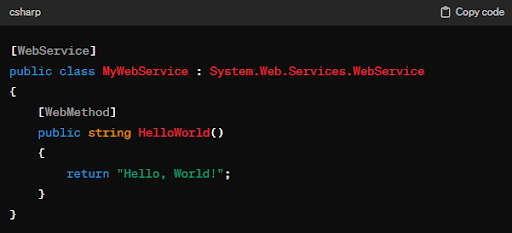ASP.NET Web Services is a powerful and versatile tool for building interoperable and scalable applications in the ever-evolving web development landscape. This blog will provide a complete understanding of what ASP.NET Web Services are, their significance in web development, their architecture, and how they facilitate seamless communication between different applications over the web.
What is ASP.NET Web Service?
ASP.NET Web Service, often simply called web service, is a standardized way for different software applications to communicate with each other over the Internet. It utilizes open standards such as HTTP, XML, and SOAP to enable seamless integration and data exchange between applications, regardless of the platform or technology they are built upon.
Critical Characteristics of ASP.NET Web Services
- Interoperability: ASP.NET Web Services are designed to be platform-independent, allowing applications developed on different technologies and platforms to communicate with each other effortlessly. This level of interoperability is achieved through the use of open standards like XML and SOAP.
- Loose Coupling: Web services promote loose coupling between applications, meaning that changes in one application do not necessarily require corresponding changes in the interacting applications. This enhances flexibility and ease of maintenance, as components can evolve independently without affecting the entire system.
- Standardized Communication: ASP.NET Web Services use protocols like HTTP and messaging formats like XML and SOAP. This standardized approach ensures consistency in data exchange and makes it easier for developers to work with web services across various platforms.
- Discoverability: Web services are discoverable through Universal Description, Discovery, and Integration (UDDI) or Service Discovery Protocol (SDP). This enables developers to find and understand available web services, fostering a more efficient development process.
Architecture of ASP.NET Web Services
- Service Description: Each ASP.NET Web Service is characterized by the utilization of the Web Services Description Language (WSDL). WSDL serves as a standardized method for outlining the features provided by a web service. This includes detailed information about input and output parameters, data types, as well as the methods that are made accessible.
- Simple Object Access Protocol (SOAP):SOAP is a communication protocol designed for the exchange of structured information within web services. It establishes a framework of guidelines for organizing messages that facilitate communication between providers and consumers of web services.
SOAP messages are typically XML-based, providing a standardized format for communication.
- Uniform Resource Identifiers (URI):Unique URIs identify web services which serve as their online addresses. This allows clients to locate and communicate with the desired web service using a standard addressing scheme.
- HTTP as the Communication Protocol:ASP.NET Web Services primarily use HTTP as the communication protocol. This protocol choice makes integrating web services into existing web applications easy and ensures compatibility with various networking environments.
Creating an ASP.NET Web Service
Creating an ASP.NET Web Service involves a series of steps, from defining the service and its methods to deploying it for consumption. Let's walk through the basic steps:
- Defining the Web Service:
To create a web service in ASP.NET, you typically start by defining a class with methods you want to expose as web service operations. Decorate the class and its methods with appropriate attributes like ‘[WebService]’ and ‘[WebMethod]’ to indicate their role in the web service.

- Configuring the Web Service:
Configure the web service in the web.config file, specifying details such as the service name, namespace, and any additional settings.

- Testing the Web Service:
Once the web service is defined and configured, you can test it locally by navigating to its URL. For example, if the web service is named "MyWebService," the URL would be like ‘http://localhost/MyWebService.asmx’.
- Consuming the Web Service:
Other applications can consume the web service by generating a proxy class using tools like "Add Service Reference" in Visual Studio. This proxy class abstracts the complexities of communication with the web service.

Benefits of Using ASP.NET Web Services
- Platform Independence: One of the primary advantages of ASP.NET Web Services is their platform independence. Applications developed on different platforms, such as Java, PHP, or .NET, can seamlessly interact with each other through web services.
- Loose Coupling and Reusability: Web services promote loose coupling between applications, allowing components to evolve independently. This enhances reusability, as different applications can reuse the same web service for various functionalities.
- Interoperability: Open standards like XML and SOAP ensure interoperability across different technologies. This is crucial in heterogeneous environments where various technologies coexist.
- Scalability: ASP.NET Web Services are scalable, making them suitable for applications with varying demand levels. As the number of clients increases, the web service can be scaled horizontally to handle the increased load.
Challenges and Best Practices
- Security Considerations: When it comes to web services, security stands as a crucial element. It's imperative to establish robust authentication and authorization mechanisms, encrypt sensitive data through HTTPS, and contemplate additional measures such as message signing to uphold communication integrity.
- Versioning: As applications evolve, web service interfaces may need to change. Implementing versioning strategies, such as maintaining backward compatibility or using version numbers in the URI, helps prevent disruptions for existing clients when updates are made.
- Error Handling: Robust error-handling mechanisms should be in place to provide meaningful error messages to clients. This helps developers diagnose and address issues promptly.
- Testing and Documentation: Thoroughly test web services under various scenarios to ensure reliability. Additionally, comprehensive documentation, including the WSDL description, helps developers understand the web service's capabilities and usage.
Conclusion
ASP.NET Web Services play a pivotal role in modern web development by facilitating seamless communication between disparate applications. Their platform independence, loose coupling, and standardized communication protocols make them versatile for building scalable and interoperable systems.
As technology advances, the role of web services in enabling integration across diverse platforms and technologies will only become more significant. Whether building a new application or enhancing an existing one, understanding and leveraging ASP.NET Web Services can contribute to developing robust and interconnected software solutions. Choose Saffron Tech, a leading web development company, if you want a reliable tech partner to build scalable and interoperable systems using ASP.NET Web Services. Get in touch with us today to learn more.
Subscribe to Saffron Tech
Explore your marketing zen with our newsletter! Subscribe now.


